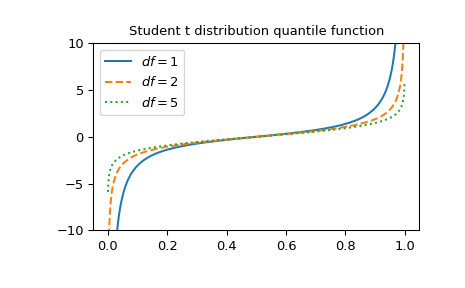scipy.special.stdtrit#
- scipy.special.stdtrit(df, p, out=None) = <ufunc 'stdtrit'>#
学生 t 分布的第 p 个分位数。
此函数是学生 t 分布累积分布函数 (CDF) 的反函数,返回 t 使得 stdtr(df, t) = p。
返回参数 t,使得 stdtr(df, t) 等于 p。
- 参数:
- dfarray_like
自由度
- parray_like
概率
- 出ndarray,可选
函数结果的可选输出数组
- 返回:
- t标量或ndarray
使得
stdtr(df, t) == p成立的 t 值
参见
stdtr学生 t 分布累积分布函数
stdtridf关于 df 的 stdtr 的逆
scipy.stats.t学生 t 分布
注释
学生 t 分布也可以通过
scipy.stats.t获得。直接调用stdtrit可以提高性能,相比于scipy.stats.t的ppf方法(见下面的最后一个例子)。示例
stdtrit表示学生 t 分布 CDF 的逆函数,该函数作为stdtr提供。在这里,我们计算df在x=1处的 CDF。然后,stdtrit在给定相同的 df 值和计算的 CDF 值的情况下,返回1直至浮点误差。>>> import numpy as np >>> from scipy.special import stdtr, stdtrit >>> import matplotlib.pyplot as plt >>> df = 3 >>> x = 1 >>> cdf_value = stdtr(df, x) >>> stdtrit(df, cdf_value) 0.9999999994418539
绘制函数以显示三种不同的自由度。
>>> x = np.linspace(0, 1, 1000) >>> parameters = [(1, "solid"), (2, "dashed"), (5, "dotted")] >>> fig, ax = plt.subplots() >>> for (df, linestyle) in parameters: ... ax.plot(x, stdtrit(df, x), ls=linestyle, label=f"$df={df}$") >>> ax.legend() >>> ax.set_ylim(-10, 10) >>> ax.set_title("Student t distribution quantile function") >>> plt.show()

通过为 df 提供一个 NumPy 数组或列表,该函数可以同时计算多个自由度的值:
>>> stdtrit([1, 2, 3], 0.7) array([0.72654253, 0.6172134 , 0.58438973])
通过为 df 和 p 提供形状兼容广播的数组,可以同时在多个点上计算多个不同自由度的函数。计算
stdtrit在 4 个点上对于 3 个自由度的结果,得到一个形状为 3x4 的数组。>>> dfs = np.array([[1], [2], [3]]) >>> p = np.array([0.2, 0.4, 0.7, 0.8]) >>> dfs.shape, p.shape ((3, 1), (4,))
>>> stdtrit(dfs, p) array([[-1.37638192, -0.3249197 , 0.72654253, 1.37638192], [-1.06066017, -0.28867513, 0.6172134 , 1.06066017], [-0.97847231, -0.27667066, 0.58438973, 0.97847231]])
t 分布也可以通过
scipy.stats.t获得。直接调用stdtrit比调用scipy.stats.t的ppf方法要快得多。要获得相同的结果,必须使用以下参数化:scipy.stats.t(df).ppf(x) = stdtrit(df, x)。>>> from scipy.stats import t >>> df, x = 3, 0.5 >>> stdtrit_result = stdtrit(df, x) # this can be faster than below >>> stats_result = t(df).ppf(x) >>> stats_result == stdtrit_result # test that results are equal True